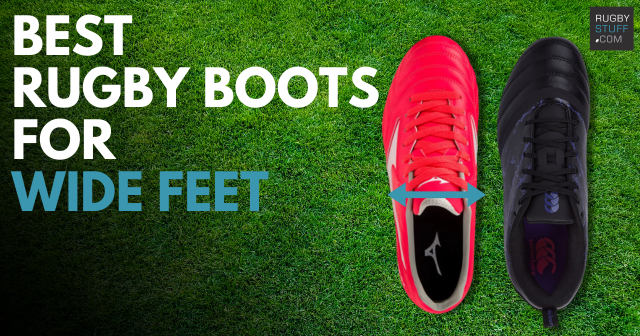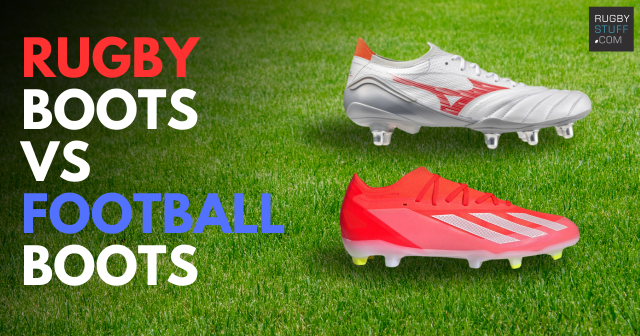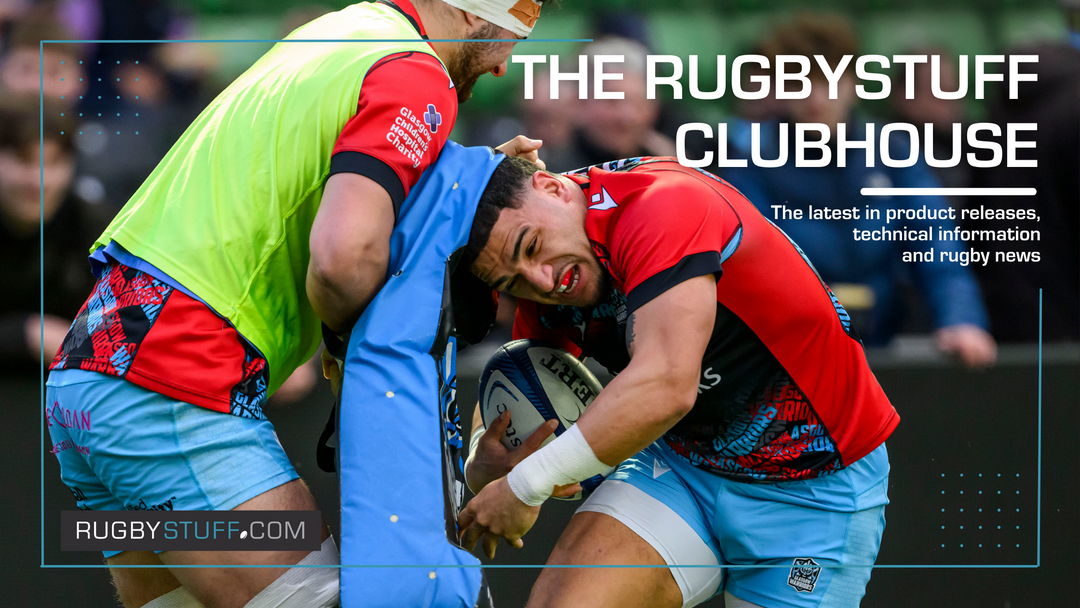The Rugby Ball Guide - Making the right choice and looking after your ball.
Rugby balls are one of the most iconic pieces of equipment associated with the sport of rugby union. Not only does a rugby ball need to be the right size for the players, but it also needs to be the right quality for the game.
So, if you want to make sure choose the best rugby ball for your game, you’ve come to the right place!
At rugbystuff.com we pride ourselves on our wide selection of Gilbert and Rhino Rugby Balls.
Gilbert Rugby have been making balls since 1823. Back then it was heavy, cumbersome leather balls, however rugby balls have come a long way since then.
Rhino was founded in 1980 and has been making rugby equipment and rugby balls ever since. They are well known for rucking shields and scrum machines but also make some great value balls.
Choosing the right rugby ball
Size
When it comes to choosing a rugby ball, one of the most important factors to consider is size.
Rugby balls are sized by age category, with size 5 being a full-size adult ball, suitable for age 15 to adult rugby in both the men's and women's games.
A size 3 rugby ball is the recommended size for children aged 6-9 and a size 4 rugby ball is for children aged 10-14.
There are other sizes on the market to consider, minis and midis - these are best suited to souvenir rugby balls, balls for babies and dog toys! These small light balls are fun to chuck about, but not a great help for practising your passing or kicking.
There are also Touch rugby balls on the market which sit between a size 4 and size 5.
Here are Gilbert Rugby Balls' official size dimensions:
Size 5 - Length 285mm, Girth 585mm (Age 15 to adult)
Size 4 - Length 275m, Girth 545mm (Age 10 to 14)
Size 3 - Length 255mm, Girth 535mm (Age 6 to 9)
Midi - Length 215mm, Girth 420mm
Mini - Length 160mm, Girth 315mm

Quality & Price
The next important aspect to consider when choosing a rugby ball is the quality of the material and price. Balls come in varying qualities from basic training balls to match rugby balls.
These can vary in price from around £10 for a standard training ball, all the way into the hundreds of pounds for your top of the range, all-singing, all-dancing match ball.
You must consider whether the rugby ball you require is for school rugby, club rugby or the Rugby World Cup final, and it must suit your budget and level of play.
Construction
Grip
The texture of a rugby ball's outer layer, specifically the "pimpled" surface, plays a crucial role in providing players with a firm grip on the ball.
The arrangement, shape, and depth of the pimples on the ball are key factors that determine its performance. The grip of a rugby ball must be balanced to ensure that it's easy to catch while also allowing for effective passing and kicking.
Different types of pimples can affect the grip and longevity of the ball.
Higher pimples generally provide more grip but reduce kicking distance, while lower, rounder pimples will last longer but provide less grip.
The grip pattern is often tailored to the specific requirements of different types of rugby games, including 15's rugby, 7's rugby, and touch rugby, each of which has varying levels of passing and kicking.
The type of rubber used to make the rugby ball can also affect its grip. Natural rubber provides greater grip while synthetic rubber offers greater durability.
Match balls tend to have a higher ratio of natural rubber to synthetic rubber to provide a better grip, while training balls often have more synthetic rubber to increase durability. No need for a pair of grip gloves when you're playing with a match ball!

Panel Construction
The construction of a rugby ball's panels is critical in determining its shape retention, weight, and energy transfer properties.
Typically, a panel comprises an outer layer with rubber and grip, and multiple layers or "plies" between the outer layer and the bladder.
Match balls are typically 3-ply in construction, while training balls are a combination of 3-ply and 2-ply.
A 3-ply ball will weigh more and be less affected by wind than a 2-ply ball, making it ideal for long-range passing and kicking.
Additionally, a 3-ply ball will usually retain its shape better than a 2-ply ball.
The materials used in the construction of the ply can also affect the ball's response to being kicked, particularly in terms of how energy is transferred to the bladder.
Cotton, poly-cotton, and synthetic materials are commonly used in rugby ball construction, with cotton being less effective at energy transfer and therefore used more often in lower-quality balls.
The best match balls typically feature synthetic ply construction using specialised energy-transferring materials.
Bladder
The bladder of a rugby ball is a critical component that greatly affects its performance. The type and size of the bladder used in a ball depends on the intended use.
Match and training balls traditionally feature a natural latex bladder, which has excellent resilience and provides good rebound characteristics.
However, the downside of natural latex bladders is that they are permeable to air and will likely require weekly reinflation.
Butyl bladders offer a great balance between feel and air retention, making them ideal for mid to upper-range balls.
On the other hand, proprietary synthetic bladders, such as Gilbert's Air-Loc bladder, have been developed to retain the qualities of natural latex without losing air.
While more expensive, these bladders can hold air for up to 1-2 months, making them a top choice for higher-quality balls.
Valve shape and placement
The valve of a rugby ball not only allows it to be inflated, but plays a crucial role in determining its performance. It acts as a weight that creates an imbalance, which can either improve or worsen the ball's performance.
High-quality match balls are designed with the valve usually placed on the seam between panels and constructed to improve the ball's rotation, leading to better accuracy and distance in passing and kicking by enhancing the spiral action.
On the other hand, the valve in lower-quality training balls is usually in the centre of a panel, and may hinder the accuracy and distance as it can offset the spiral action due to the imbalance.
Pre-Kicking
Occasionally, you may come across the term "Pre-Kicked" when referring to the bladder in high-end match balls.
Although it may appear unnecessary, this mechanical process in the factory helps the ball to attain its intended shape faster after inflation and also aids in identifying any production faults.
This is just one more benefit that distinguishes a top-quality match ball from other types of balls. With perfect rugby boots and kicking tees, you'll be set for goal-kicking success.
Taking Care of Your Ball
Pressure
It is important to ensure that all rugby balls are inflated to the correct pressure of 9.5 psi for optimal performance. It is not recommended to overinflate a ball and then reduce the pressure down to 9.5 psi, as this can affect the shape and performance of the ball permanently.
Therefore, it is essential to check the pressure and adjust it accordingly before use, as slight variations in ball pressure can occur due to natural bladder materials and external climate changes.
To avoid any damage to the ball, it is recommended to use a stirrup pump or a hand pump for inflation. The use of compressors or airlines is not recommended as it can cause over inflation, leading to changes in the ball's properties.
Storage
To extend the lifespan of your ball it's important to store it in optimal conditions, which involves keeping it in a dry environment.
Although the ball is designed to be waterproof, leaving it in a damp setting (the back garden!) can result in the accumulation of small amounts of water inside, which can increase the ball's weight and ultimately impact your on-field performance while shortening the ball's overall lifespan.
Cleaning
We know nobody is going to clean their rugby ball before every training session, however certainly before a match it is worth cleaning your ball to remove any mud or residue.
Do this with a soft cloth, a light detergent and warm water to ensure the grip is kept in its optimum condition for the maximum length of time.
We've all seen the towels pitch side during a game - the pros use them for exactly this.
Types of Rugby Ball
Match
Match rugby balls are what should be used in a match environment.
These can vary in quality from ones suitable for amateur rugby clubs right up to Gilbert's latest top-level match balls which cost up to £150 and would be exactly what is used in top-level international rugby.
They feature the best bladders, in-seam valves, 3-ply construction and high-grade natural rubber grip. Look out for the Gilbert Barbarian or go all out with the Gilbert Sirius.

Training
Training rugby balls are far more cost-effective than match balls and are built to withstand the abuse of regular training sessions.
They feature butyl bladders, in-panel valves, 2-ply construction and synthetic rubber outer grip.
Rugbystuff recommendation - Rhino Cyclone. Available in all sizes and 3 different colours, it's the cheapest rugby ball out there but won't let you down.
Touch
Touch Rugby balls are designed for maximum grip with large rubber dimples, terrible for kicking but great for ball handling! They are sized between a size 4 and size 5 ball making them light and fast for a quick passing game like touch.
Rugbystuff recommendation - Gilbert Pro Touch. Made for the top level, the grip on this ball is insane!
Sevens
Sevens rugby balls are crafted to optimize passing and catching abilities, considering the lesser use of kicking compared to 15-a-side rugby.
Therefore, the grip of these balls is usually highly assertive, featuring angular dots, and the ball's shape is slightly more streamlined, akin to a torpedo.
This design ensures that the ball can be handled with ease, albeit making it marginally challenging to kick.
Beach Rugby
Beach rugby balls possess a somewhat soft and pliable exterior, are super-light, and are tailored to function seamlessly even when wet and caked with sand.
They make a great choice for a 'chuck about' given their softer composition, great grip and lightweight!
Rugbystuff recommendation - Rhino Barracuda. Bright colours and a unique Diamond grip provides extra handling performance on the sand, giving you an edge over your opponents.
Weighted and Specialist Training
There is a variety of specialist training rugby balls on the market designed to bring variety to your training.
The Gilbert Morgan or Rhino Storm Pass Developers are double-weight balls. These are ideal for building up wrist strength and bringing some zip to your passes when returning to a regular ball, great for scrum halves!
The Gilbert Rebounder or Rhino Reflex balls are essentially rugby balls sliced in half, retaining the weight of a regular ball, and enabling you to emulate identical passing mechanics to a full-sized ball without a partner's assistance.
They will bounce straight back to you from any wall!
They prove to be exceptional for individual skill-building exercises and honing your passing skills. Furthermore, they function adeptly for traditional spin passes, line-out throws, and even end-on-end kicks.
Another training ball from Rhino is the Mistral, which features no grip whatsoever. Ideal for emulating damp conditions when the ball is slippy. Great for passing practice but even better for catching practice. Try getting under a high ball with no grip!
The Rhino Sponge Ball is the safe choice for young children looking for a fun rugby ball to play and train with around the house. They won't damage the valuables at home, even when they get enthusiastic!

Replica
It might be that you just want to show your support for your favourite team of club, and Gilbert have the largest range of officially licensed replica rugby balls in the world!
No matter who you support, there's a replica ball for you at Rugbystuff.com
In conclusion, when it comes to purchasing a Rhino Rugby Ball or Gilbert rugby ball, quality and price are important factors to consider.
While higher-quality rugby balls may be more expensive, there are many affordable options on the market that offer good performance and durability.
By doing your research and considering your needs and budget, you can find a rugby ball at Rugbystuff.com that meets your needs without breaking the bank.











Can I play 🏉 for the c
Which ball is best for tossing around between friends. I want one that is not too rough on my hands, but throws well.
Leave a comment